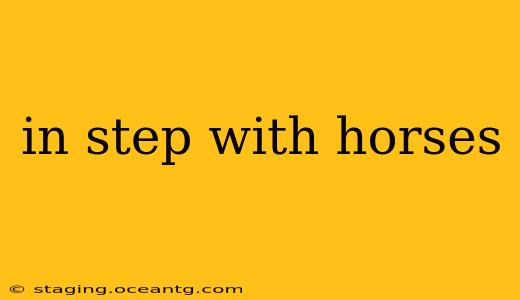Horses, majestic creatures of power and grace, captivate us with their fluid movements. Understanding their gait – the pattern of their legs during locomotion – offers a deeper appreciation for these magnificent animals. This guide delves into the intricacies of equine gait, exploring the various gaits, their characteristics, and how to better understand and appreciate the horse's movement.
What are the different gaits of a horse?
Horses possess a fascinating array of gaits, each characterized by a unique sequence of leg movements. The most common gaits include:
- Walk: A four-beat gait, with each foot striking the ground individually. It's the most relaxed and energy-efficient gait for the horse.
- Trot: A two-beat gait, with diagonal pairs of legs moving simultaneously. It's a faster gait than the walk, characterized by a bouncing rhythm.
- Canter/Lope: A three-beat gait, where the horse moves in a more collected and controlled manner than the gallop. The canter is smoother and more collected than the gallop.
- Gallop: A four-beat gait, considered the fastest gait a horse can perform. It involves a period of suspension where all four feet are off the ground.
How can I tell the difference between a trot and a canter?
The primary difference lies in the rhythm and number of beats. The trot is a distinct two-beat gait, often described as a rhythmic bounce. The canter, on the other hand, is a three-beat gait, with a more flowing and less jarring movement. Observing the sequence of leg movements will also help distinguish between the two. The canter has a characteristic suspension phase where the horse is briefly airborne, while the trot does not have a prolonged suspension.
What is a pace?
The pace is a less common gait, primarily seen in certain breeds like the Paso Fino or Tennessee Walking Horse. It's a two-beat lateral gait, meaning the legs on the same side move together in unison. It's a smooth, gliding gait, characterized by its lateral rhythm.
How does a horse’s gait affect its performance?
A horse's gait directly impacts its performance in various disciplines. For example, in dressage, smooth and controlled gaits are crucial for achieving high scores. In racing, the gallop is essential for achieving maximum speed. Understanding the nuances of different gaits helps riders optimize their horse's performance and ensure their comfort and well-being.
What factors influence a horse's gait?
Several factors can influence a horse's gait, including:
- Breed: Certain breeds are predisposed to specific gaits.
- Conformation: A horse's physical structure significantly impacts its movement.
- Training: Proper training helps horses develop correct and efficient gaits.
- Rider: The rider's skill and balance influence the horse's gait.
- Terrain: Uneven terrain can affect the horse’s stride.
How can I improve my understanding of horse gaits?
The best way to improve your understanding of horse gaits is through observation and experience. Spend time watching horses move, paying attention to the rhythm and sequence of their leg movements. Consider attending equestrian events or taking lessons to learn more about equine movement. Reading books and articles on equine locomotion can also enhance your knowledge.
By understanding the intricacies of horse gaits, we gain a deeper appreciation for these incredible animals and their remarkable athleticism. This knowledge is invaluable for riders, trainers, and anyone fascinated by the beauty and complexity of equine movement.
